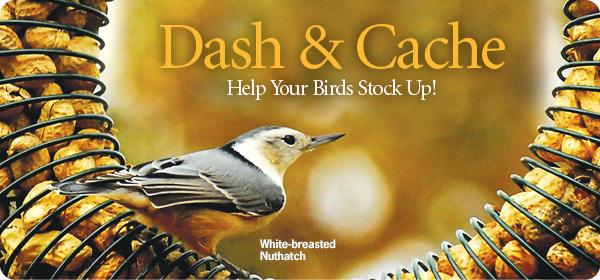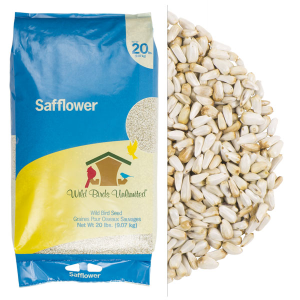
Being Seasonally Savvy: Cashing in on Caching
Right now chickadees, nuthatches, titmice and jays are hiding food to retrieve and eat later this season. This behavior is called “caching.” Caching helps birds survive during bad weather and when food sources are low. These birds can store hundreds of seeds a day. Each seed is placed in a different location and they generally remember where each one is, even months later.
By providing a foundational feeder filled with their favorite foods, you can help your birds with their caching needs. Recent research has shown that a consistent and reliable source of food helps birds to build body fat reserves, reduces their physiological stress and helps to maintain a healthy body condition.
Chickadees prefer to cache black oil sunflower seeds; often eating a small portion before hiding it in and under bark, dead leaves, knotholes, clusters of pine needles, gutters, shingles and in the ground. Chickadees cache more in the middle of the day when visiting feeders.
Titmice are rather particular. They choose the largest sunflower seeds available to eat and cache. Titmice and chickadees like to cache seeds within 130 feet of bird feeders; your yard or a neighbor's yard. Often, they tuck seeds into the bark and crevices of a wood pile or on a large branch. They even cache them under mulch in a garden.
Nuthatches prefer heavier sunflower seeds over the lighter ones. Be sure to have some sunflower chips in your blend, too, as they like these 25% more than ones in the shell. They prefer to hide foods on deeply furrowed tree trunks and the underside of branches. Nuthatches are also known to hide seeds under a shingle or behind wooden siding.
Jays love to cache peanuts, sunflower seeds, acorns and pine nuts. They are especially fond of peanuts in the shell. They bury them in the ground and are known to cache about 100 in a day; emptying a feeder in no time. Watch for them making repeated trips to your feeders (or an oak or pine tree) and flying off. They can travel up to two miles to bury their nutritious treasure.

More than 300 bird species found in North America during the summer will migrate to Latin America or the Caribbean, some covering distances of nearly 7,000 miles. Parks, backyards and nature refuges across the country will host these winged visitors for the next few weeks as the birds make their way to their fall and winter destinations. Here are three things you can do to help them along on their journey.
1. Provide Food
Provide foods high in fat such as suet, bark butter, and a seed blend with lots of sunflower seeds to help birds refuel. They need high calorie foods to help replenish their energy supply. Putting out bird feeders, seed, fruit and nectar feeders, and fruit can help birds along their journey.
2. Provide Water
Whether they are feeder visitors or not, birds need water for drinking, bathing and preening. Birds need open water sources for drinking and keeping their feathers maintained for flight and proper insulation as the nights get colder. Providing water can be as simple as putting out a bird bath or as complicated as installing a pond with a creek and waterfall.
3. Provide Habitat or Shelter
Birds need a safe place to rest. You can create and restore habitat at home, at your workplace and in your local park or wildlife refuge. You can make any property attractive to birds by offering more natural habitat, like native trees and flowers, brush piles, and leaf litter. Evergreen trees make great roosting sites for chilly nights.




